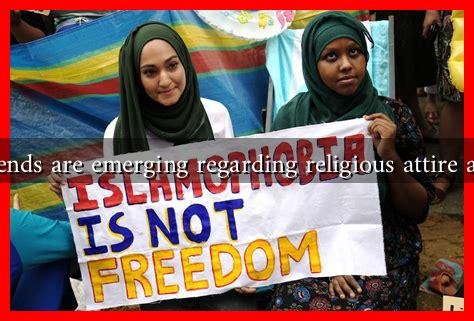-
Table of Contents
Emerging Global Trends in Religious Attire and Secularism
In an increasingly interconnected world, the dynamics between religious attire and secularism are evolving rapidly. As societies grapple with issues of identity, freedom, and expression, the way individuals choose to dress in accordance with their beliefs is becoming a focal point of discussion. This article explores the emerging global trends regarding religious attire and secularism, highlighting key examples, case studies, and statistics that illustrate these shifts.
The Rise of Religious Attire in Secular Spaces
One of the most notable trends is the increasing visibility of religious attire in secular environments. This phenomenon can be attributed to several factors:
- Globalization: The movement of people across borders has led to a greater exchange of cultural practices, including modes of dress.
- Social Media: Platforms like Instagram and TikTok have allowed individuals to showcase their religious attire, normalizing its presence in everyday life.
- Advocacy for Religious Freedom: Many activists and organizations are working to promote the rights of individuals to express their religious beliefs through attire.
For instance, the hijab has gained prominence in Western countries, with many Muslim women choosing to wear it as a symbol of empowerment rather than oppression. A study by the Pew Research Center found that 62% of Muslim women in the U.S. feel that wearing the hijab is a personal choice that reflects their identity.
Secularism and Its Impact on Religious Attire
As secularism continues to rise, particularly in Western nations, the relationship between religious attire and public life is becoming increasingly complex. Secularism advocates for the separation of religion from civic affairs, which can lead to tensions regarding the visibility of religious symbols. Key points include:
- Legislation: Countries like France have implemented laws banning conspicuous religious symbols in public schools, which has sparked debates about freedom of expression.
- Public Perception: In many secular societies, religious attire is often viewed with suspicion, leading to discrimination and social stigmatization.
- Counter Movements: In response to secular policies, there has been a rise in movements advocating for the acceptance of religious attire in public spaces.
For example, the 2010 ban on the burqa in France led to widespread protests and discussions about the implications for personal freedom and cultural identity. Many women argued that the ban infringed upon their rights to express their faith.
Case Studies: Global Perspectives
Examining different countries provides insight into how religious attire and secularism interact:
- Turkey: The lifting of the ban on headscarves in public institutions in 2013 marked a significant shift towards accommodating religious attire in a predominantly secular state.
- India: The ongoing debates surrounding the wearing of hijabs in schools highlight the tensions between religious freedom and secular education policies.
- United States: The rise of the “modest fashion” movement has seen an increase in the popularity of religious attire among non-Muslims, showcasing a blend of cultural influences.
These case studies illustrate the diverse ways in which societies are navigating the complexities of religious attire and secularism, often leading to both conflict and collaboration.
Statistics and Public Opinion
Public opinion on religious attire varies significantly across different regions. According to a 2021 survey by the European Union Agency for Fundamental Rights:
- Over 50% of respondents in several EU countries expressed support for the right to wear religious symbols.
- However, 30% reported experiencing discrimination based on their religious attire.
This data underscores the ongoing challenges faced by individuals who choose to express their faith through their clothing, even in societies that advocate for religious freedom.
Conclusion: Navigating the Future of Religious Attire and Secularism
The interplay between religious attire and secularism is a dynamic and evolving landscape. As globalization continues to influence cultural exchanges, and as movements advocating for religious freedom gain momentum, the visibility of religious attire in secular spaces is likely to increase. However, this trend will also face challenges from secular policies and public perceptions.
Ultimately, fostering a society that respects both individual expression and secular principles will require ongoing dialogue and understanding. As we move forward, it is essential to recognize the value of diversity in attire as a reflection of personal identity and belief systems, paving the way for a more inclusive future.
For further reading on this topic, you can explore resources from the Pew Research Center and the European Union Agency for Fundamental Rights.

